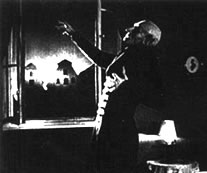|
The need to imagine and create Balkan monsters was already
a long established tradition in western europe and britain
when Stoker published Dracula in 1897 (during the days of
the infamous "Near East" Question aimed at the Balkans).
According to Stephen Arata, in the marauding, invasive Other
that Dracula embodies, British culture saw its own imperial
practices mirrored back to itself in a monstrous form, representing
its own fear of reverse colonization. For Goldsworthy, Dracula
is a metaphor for the Balkan condition, for the Western demonisation
of the Balkan's status in Europe a as site of monstrous impurity.
From a British standpoint, Dracula's rapid advance as an alien
force in London is particularly threatening because he makes
himself invisible among the English, an insidious but no less
monstrous 'other'.
In his version of Dracula, Stoker reproduces a British anthropologist's
misspelling of the word vlkoslak. The reference is to the
word vukodlak, the Serbian word for werewolf. Stoker also
has his monster speaking of the "the great shame of my
nation… the shame of Cassova." This is a reference
to the Battle of Kosovo of 1389, the site of the mythic defeat
of Serbia by the Ottoman Turks in Serbian national mythology.
Current media representations of the Balkans remain haunted
by this monstrous spectre of vampirism. During the NATO bombing,
representations of the Serbs as a primitive, irrational, bloodthirsty
and monstrous peoples reached their pinnacle, in both subtle
and not so suble
form. To cite a typical example: in a story that NATO
ultimately had to acknowledge was false and admit responsibility
for after one of their missiles struck a convoy of kosovar
refugees, the London Sun ran the headline, "Serb Monsters
Shot Refugees then Blamed Us" (April 20, 1999). This
tradition of staged horror and exercised revulsion is part
of long term historical lens through which the west views
the Balkans, but rarely if ever interrogates from its standpoint
of proclaimed superior rationality and humanitarianism.
|

